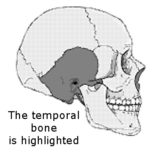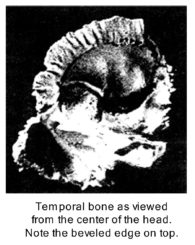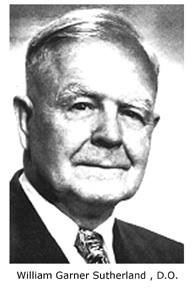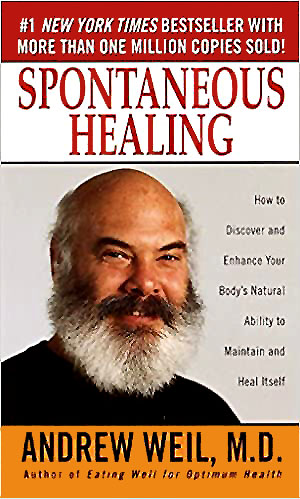What is the Craniosacral Work?
The Birth of an Idea
As a young student in osteopathic college, William Sutherland (the founder of the craniosacral work 1873 –1954) became absorbed looking at the bones of the skull. In particular, he was looking at the temporal bone. It is the bone beneath the surface of the ear. He wondered why the edge of the temporal bone should have an angled or beveled shape. Most of the bones of the cranium have an edge like fingers interlaced with each other. These finger-like edges weave adjacent bones together seemingly locking them into place. However, the beveled edge of the temporal would not allow this same type of locking. then it hit him in an intuitive flash! “Beveled for movement. Like the gills of a fish.” Why would the bones of the skull move? This question started him on many years of study and experimentation. His goal was to try and understand this mystery of motion in the cranium. What he came up with is a remarkable system of healing.


The Movement of Life
Scientific study has born out the principles of Dr. Sutherland’s work. With the advent of the electron microscope scientists have been able to demonstrate conclusively that the cranial bones do move. There is now a good working model of how and why they move. It has been demonstrated that there are regular rhythmic movements of the skull. A slight expansion and slight contraction which occur about twelve cycles per minute. The technical term for this movement is the cerebrospinal fluid pulse wave. Doctor Sutherland called it the craniosacral motion. This movement occurs independent of the heartbeat or breathing. This means that when the heartbeat or the breathing increase due to exertion, the craniosacral rate of motion remains constant at twelve cycles per minute. The craniosacral motion is responsible for the circulation of cerebrospinal fluid. Cerebrospinal fluid is essential to life. It carries nutrients and oxygen to the cells of the brain and spinal chord. This process is an essential part of what is called cellular respiration. Dr. Sutherland called this process the primary respiratory mechanism.
He felt it was the place where Spirit gave life to the body. As breathing expands and contracts the lungs, one cycle of the craniosacral motion expands and contracts the head. Because the primary respiratory mechanism is so fundamental to life, the craniosacral motion can be felt all over the body. Instruments that measure minute changes of volume can detect the craniosacral motion at the tip of the finger. A craniosacral practitioner is trained to use their hands to feel the intricacies of the craniosacral motion. It is amazing, to feel this deep, primary movement of life in the body. It is the pulse of life coursing through the human body.

This provides a detailed and holistic evaluation of the muscles, joints and tissues of the entire body. The precise area of restrictions in muscles and fascia can be located. Most postural imbalances can be evaluated without the need for X-rays. Because the craniosacral pulse is the same as what the Chinese call “life force” or chi, assessments based on the principles of oriental medicine become possible. This detailed and holistic evaluation provides valuable diagnostic information important for the application of therapy.

The Fulcrum of Change
Dr. Sutherland developed many valuable and unique therapies. They include specialized therapies for the cranium (the bones of the head and face) and sacrum (a triangular shaped portion of the spine which is situated between the pelvic bones). Craniosacral therapy draws its name from this. Treatment however, is not limited to the cranium and sacrum. Any area of the body may be treated. Although there is usually a special focus on the problem areas. Traditional craniosacral therapy employs allied therapies which include: soft tissue massage, acupressure, myofascial release and chiropractic adjustments. During the administration of therapy, the doctor maintains a high level of sensitivity to the patient. The hand that administers therapy is the same one that evaluates the patient’s response to therapy. Each site of tension (or restriction) tightens, twists or distorts the muscles, fascia and joints in a unique manner. The doctor’s hands follow these twists and turns, easing in, like a key slipping into a lock. With the proper hand position, body position, and the right amount of pressure on the tissues, the hands provide a fulcrum for change. The goal is to open and free areas of restriction, allowing the body to heal itself. Unlocking the tension is done by the innate healing force within each person. Tissues that are twisted, tight and convoluted begin to unwind and tension is released. Just as anatomical shapes effect the character of the craniosacral pulse, the unique presentation of restriction in each patient effects the character of the therapeutic application. The doctor reads the craniosacral pulse for clues: “How does the innate healing ability want to release this tension?” and places his hands accordingly.
The body can be an intricate web of restrictions, or it can efficiently deal with muscular tension and stress. Craniosacral chiropractic is a valuable tool for relieving tension, chronic and acute pain and promoting health. The first treatment lasts about an hour. Follow up treatments take about half an hour. The number of treatments depends upon the nature of the patient’s injury or chronic condition. Relief of pain and improvement of symptoms are usually seen on the first visit. To speed healing and decrease a patient’s dependence on treatment, recommendations for exercise and stretching are frequently given. Patients are encouraged to be active participants in the process of their own recovery. After specific problems have been corrected, many patients continue on with periodic visits to help maintain optimum health.
A Modern Day Legend
In the popular book on alternative medicine, Spontaneous Healing, author Andrew Weil, M.D., devotes a whole chapter to a remarkable healer by the name of Robert Fulford, D.O. Dr. Fulford is an osteopath who studied craniosacral therapy directly from its founder, Dr. Sutherland. The book makes frequent reference to the uncanny healing ability that Dr. Fulford possessed. When asked about this by patients he would say something simple like: “I took the shock out of your system. Now just let old Mother Nature do her job.” But Dr. Fulford knows full well the power of this form of healing. In a talk given in 1987 he described how Dr. Sutherland rediscovered something that was known to the ancient Chinese. He said how sixth century Taoist healers were the first to describe the craniosacral pump. He explained how Dr. Sutherland’s earliest classes taught cranial anatomy in depth, but it also covered more esoteric subjects like the role of the etheric body in healing. Dr. Weil was sufficiently impressed by Dr. Fulford that he convinced the University of Arizona to launch an in depth study on “energy medicine”. Energy Medicine is doctor Weil’s term for this type of healing.

Address
4340 Redwood Hwy, Suite F-106
San Rafael
CA 94903
Office Hours
MONDAY: 9:00 – 5:00
TUESDAY: 9:00 – 5:00
THURSDAY: 9:00- 5:00
Contact
Please Call To
Make an Appointment
(415) 446-7285
